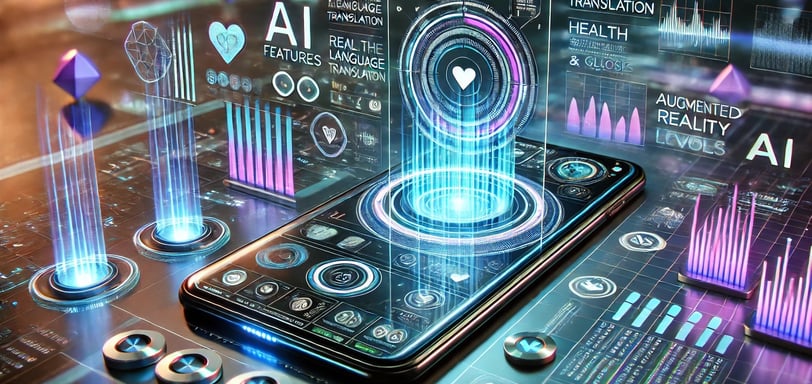The Rise of AI-Integrated Smartphones in 2025: A New Era of Smart Technology
Explore the AI revolution in smartphones with upcoming devices like the Galaxy S25 Ultra and iPhone 16 Pro. From health tracking to predictive AR, discover how AI is transforming mobile technology in 2025!


Introduction
Smartphones have become more than just communication tools; they are now our personal assistants, health trackers, and even creative companions. In 2025, the integration of Artificial Intelligence (AI) into smartphones is set to redefine what these devices can do. From personalized user experiences to health monitoring and augmented reality (AR) capabilities, AI-powered smartphones are leading a revolution in technology.
This blog takes an in-depth look at how AI is shaping the next generation of smartphones, the features you can expect, and the flagship devices set to dominate the market.
1. The Role of AI in Smartphones
AI has transitioned from being a supporting feature to becoming the core of smartphone functionality. Here’s how it’s making a difference:
1.1. Personalized User Experiences
• What It Means: AI learns user behavior over time to provide a tailored experience.
• Examples:
• Apps are arranged based on usage patterns.
• Notifications are prioritized intelligently to reduce distractions.
• Future Potential:
• AI could anticipate user needs, such as suggesting apps before you even think of using them.
1.2. Enhanced Photography
• What It Means: AI powers advanced photography tools that automatically enhance images.
• Examples:
• Scene optimization adjusts lighting and color for perfect shots.
• Real-time object removal edits unwanted elements from photos instantly.
• Future Potential:
• AI could enable 3D photo capturing and immersive storytelling through augmented visuals.
1.3. Health Monitoring and Diagnostics
• What It Means: Smartphones use AI to monitor health metrics and provide actionable insights.
• Examples:
• Google Pixel 8 Pro already features a temperature sensor.
• AI-driven analysis of sleep patterns and stress levels.
• Future Potential:
• Smartphones could perform non-invasive blood tests or detect early signs of diseases.
1.4. Seamless Multitasking
• What It Means: AI optimizes performance by allocating resources based on usage.
• Examples:
• Apps resume exactly where you left off, even after hours.
• AI predicts frequently used features and pre-loads them to save time.
• Future Potential:
• AI could create virtual desktops, allowing users to switch between work and personal environments instantly.
2. Flagship AI-Integrated Smartphones of 2025
Here are some upcoming devices that are pushing AI integration to new heights:
2.1. Samsung Galaxy S25 Ultra
• Key Features:
• AI-enhanced camera system with 200MP sensors for unmatched detail.
• Personalized AI assistant to manage tasks and optimize battery life.
• Advanced health monitoring tools, including blood pressure tracking.
• Why It’s Exciting:
• Samsung’s integration of AI into its One UI interface makes the Galaxy S25 Ultra a productivity powerhouse.
2.2. Apple iPhone 16 Pro
• Key Features:
• Siri upgrades with conversational AI, offering more natural interactions.
• AI-powered photo editing that automatically creates albums based on themes.
• AR glasses compatibility for immersive experiences.
• Why It’s Exciting:
• Apple’s focus on integrating AI with AR opens up new possibilities for gaming, learning, and navigation.
2.3. Nothing Phone (3)
• Key Features:
• Minimalist design with an AI-driven interface that adapts to user habits.
• AI reduces screen distractions by prioritizing essential notifications.
• Why It’s Exciting:
• The focus on simplicity and functionality sets it apart from other flagship devices.
3. Game-Changing AI Features to Watch
3.1. Real-Time Language Translation
• How It Works:
• AI-powered cameras and microphones translate text and speech in real-time.
• Example:
• Traveling abroad becomes seamless as your phone translates signs and conversations instantly.
3.2. AI-Powered Battery Optimization
• How It Works:
• AI analyzes usage patterns to optimize battery consumption.
• Example:
• Unused apps are put into deep sleep, and power-intensive features are managed dynamically.
3.3. Predictive Augmented Reality (AR)
• How It Works:
• AI enables AR features like virtual furniture placement or real-time gaming overlays.
• Example:
• Visualize how a new couch would look in your living room using your phone’s AR feature.
3.4. Advanced Security
• How It Works:
• AI monitors for unusual activity and enhances biometric authentication.
• Example:
• Facial recognition adapts to changes like glasses or beards for seamless unlocking.
4. The Future of AI in Smartphones
4.1. AI-First Operating Systems
• Future smartphones may feature operating systems built entirely around AI, optimizing every aspect of user interaction.
4.2. Health as a Priority
• AI could turn smartphones into diagnostic tools, capable of detecting diseases like diabetes or cardiovascular issues early.
4.3. AI-Powered Personal Assistants
• Virtual assistants could evolve into proactive companions, offering life management solutions beyond reminders and weather updates.
5. Challenges and Ethical Considerations
5.1. Data Privacy
• AI relies on user data to function effectively, raising concerns about how this data is stored and used.
5.2. Accessibility
• Advanced AI features may initially be available only on premium devices, creating a gap in accessibility.
5.3. Over-Reliance on AI
• Users might become too dependent on AI, potentially reducing critical thinking or decision-making skills.
Conclusion
The integration of AI into smartphones is more than just a technological advancement—it’s a paradigm shift. Devices like the Samsung Galaxy S25 Ultra, Apple iPhone 16 Pro, and Nothing Phone (3) are setting new standards for what smartphones can achieve. With features like real-time health monitoring, predictive AR, and AI-driven personalization, the future of mobile technology is bright, intelligent, and limitless.
